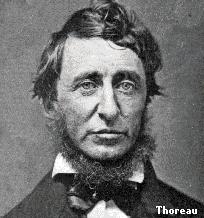the john muir exhibit - people - henry david thoreau
Henry David Thoreau
1817-1862

- Writer and poet, best known for the journal he kept at Walden Pond, which became the source of his most famous book, Walden, Or Life in the Woods (1854)
- Although John Muir never met Henry David Thoreau in person, he was indebted to him as his spiritual and literary mentor.
- According to Richard Fleck in his book Henry Thoreau and John Muir Among the Native Americans (1983), "The closest their paths came to crossing came in the spring of 1861 when Thoreau traveled to Minnesota via the Mississippi River from East Dubuque, Illinois, past Prairie du Chien, Wisconsin, to Fountain City, Wisconsin, and St. Paul, Minnesota." Thoreau's return trip was in June 1861. During this same period, John Muir had left the University of Wisconsin in Madison to return home for his summer at at the Muir farm in Hickory Hill, not far from Portage, Wisconsin. Fleck writes, "I suppose Thoreau and Muir were but fifty miles apart when Thoreau rode the train from Prairie du Chien to Milwaukee on 26 June 1861. (It is even possible that they unknowingly crossed paths in Madison, according to Edmund A. Schofield in his article "Muir and the New England Connection.")" (Schofield imagines a scenario, based on the eight minutes Thoreau's train stopped in Madison, that "while admiring Lake Mendota through the train window, he just might have spied a lone figure atop a small prominence at the far end of the lake." In turn, if Muir were casting one last glance back toward the campus as he left for home, for just an instant he might have seen a train pulling into view cutting across a far corner of the University of Wisconsin campus on its way east.)
- John
Muir first became acquainted with the writings of Thoreau and
Ralph Waldo Emerson in 1862 (the year of Thoreau's death) when
Muir was at the University of Wisconsin. He apparently continued
to read Thoreau over the rest of his life.
- Muir wrote to Jeanne Carr on May 29, 1870 that he had recently read Thoreau's Maine Woods. In 1872, a friend sent Muir a copy of Thoreau's Walden, which remained in Muir's library the rest of his life. In 1879, Muir took a copy of The Maine Woods on his first trip to Alaska.
- Muir's
copy of the twenty-volume, 1906 edition of The Writings
of Henry David Thoreau is
heavily annotated, underscored, and indexed on the blank pages
with extensive commentary by Muir.
- Several of Muir's literary passages reflect Thoreau, including his comments on "sauntering" and their shared thought that in "wildness lies the hope of the world." But, as Richard Fleck in Henry David Thoreau and John Muir Among the Indians writes, "John Muir was no rote imitator of Thoreau but rather a thoughtful integrator of this New England master into his own system of Sierra values."
- Despite his admiration for Thoreau's writings, Muir found both Emerson and Thoreau insufficiently wild. Muir wrote, "Even open-eyed Thoreau would perhaps have done well had he extended his walks westward to see what God had to show in the lofty sunset mountains."
- According to Muir's friend Henry
Fairfield Osborn, Muir "is a very firm believer in Thoreau and starts my reading deeply of this author... In his attitude toward nature, as well as in his special gifts and abilities, Muir shares many qualities with Thoreau. First among these is his mechanical ability, his fondness for the handling of tools; second, his close identification with nature; third, his interpretation of the religious spirit of nature; fourth, his happiness in solitude with nature; fifth, his lack of sympathy with crowds of people; sixth, his intense love of animals." Osborn goes on to stress that "Thoreau's quiet residence at Walden is to be contrasted with Muir's world-wide journeyings."
See John Muir by Henry Fairfield Osborn.
- In June 1893, John Muir visited Sleepy Hollow Cemetery in Concord and laid flowers on Thoreau's and Emerson's graves. He then visited Walden Pond, reflecting, "No wonder Thoreau lived here two years. I could have enjoyed living here two hundred or two thousand. It is only about one and a half or two miles from Concord, a mere saunter, and how people should regard Thoreau as a hermit on account of his little delightful stay here I cannot guess." Life and Letters of John Muir, Chapter XVI, Trees and Travel, 1891-1897.
- According to Muir's friend John
Swett, on his return from seeing Yosemite with John Muir, Emerson said of Muir, "He is more wonderful than Thoreau."
- This view was reiterated by one of Muir's admirers, Alden Sampson, wrote "The Creating of Game Refuges" in a 1904 book of the Boone and Crockett club American Big Game in its Haunts, contrasting Thoreau with Muir, wrote of Muir,"Recognizing the fine endowments of Thoreau, and how greatly all are his debtors, still we of this generation are lucky in having one greater than he among us, if wisdom of life and joyousness be the criterion of a sound and of a sane philosophy... In him [Muir] we see the trained faculties of the close and accurate observer, joined to the temperament of the poet -- the capacity to think, to see and to feel -- and by the power of sustained and strong emotion to make us the sharers of his joy... Compare the career of Thoreau, lonely, sad, and wedded to death -- on the one hand, with that of Muir, on the other -- a lover of his kind, healthful, inspiring to gaiety, superabounding in vitality. Naturalists of this type of mind, and so faithful in perfecting the talents entrusted to them, do not often appear in any age."
Home
| Alphabetical Index
| What's New